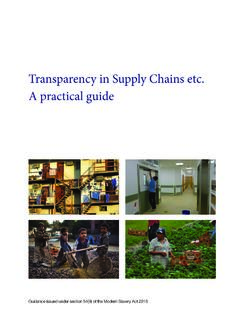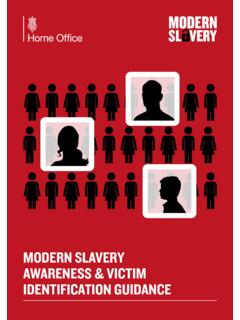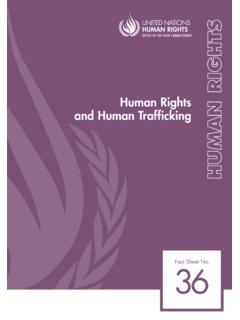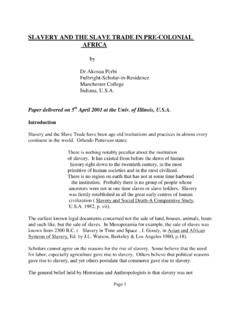Transcription of A Guide to the History of Slavery in Maryland
1 ISBN 9780942370133A Guide to the History of Slavery in MarylandTHE Maryland STATE ARCHIVES, ANNAPOLIS, MARYLANDREVISED EDITION 2020A Guide to the History of Slavery in MarylandFigure 1: Engraving of Africans unloading tobacco on a Chesapeake Bay wharf, c. Guide to the History of Slavery in Maryland Copyright 2020S lavery and its tragic legacy have played a significant role in our nation s History and have become an important part of the American consciousness. They have been the subject of numerous movies, documentaries, podcasts, museum exhibitions and monuments, as well as books, and multi-media journalistic publications. Their place in American culture has shaped and informed local and national politics, congressional hearings, legislative policies and apologies, lawsuits, and the matter of reparations. In such an environment, Slavery and its role in Maryland s History demand that chattel bondage be addressed in classrooms and other forums.
2 This Guide to the History of Slavery in Maryland provides a brief, but comprehensive, overview of the History of Slavery in the state. Built upon the most recent scholarship, this Guide offers teachers and students a starting point from which to begin their own exploration of an institution that, in so many ways, has shaped our modern 2: Woodcut depicting an enslaved man in chains which appeared on the 1837 broadside publication of John Greenleaf Whittier s antislavery poem, Our Countrymen in Chains. 1 From the colony s founding in 1634 until the state abolished Slavery in 1864, enslaved Africans and African Americans were important in shaping Maryland s History . Their labor, and the commodities it produced, provided the foundation for Maryland s economy and formed its society. Enslaved workers on the tobacco plantations fueled the colony s economic growth during the seventeenth and eighteenth centuries.
3 The fortunes amassed from the free toil of enslaved men, women, and children allowed Maryland s gentry to dominate colonial politics and propelled some to national prominence. By the nineteenth century, enslaved people could be found in every corner of Maryland : laboring in Cecil County s iron furnaces; harvesting wheat in Washington County; and caulking ships in Baltimore s harbor, like skilled enslaved artisan Frederick Douglass. During the Civil War, African Americans reclaimed their freedom, but the weight of Slavery s History was not easily obliterated, as it continued to cast a long shadow over the state. Slavery s influence can still be felt, as debates about public monuments, the state song and reparations demonstrate. African Americans have endured poverty and discrimination into the twenty-first century.
4 In 2000, recognizing Slavery s importance to Maryland s History , the legislature created the Commission to Coordinate the Study, Commemoration, and Impact of Slavery s History and Legacy. Seven years later, both houses of the Maryland legislature and the Annapolis City Council officially expressed their regret for the role Maryland played in instituting and maintaining Slavery . As the official apologies affirm, Slavery is now recognized as a heinous crime, but, for most of human History , few whites considered it either illegal or immoral. Slavery flourished in ancient Greece and Rome and is present in the Bible, Koran, and other sacred texts. Customs and law in Africa, Europe, and the Americas justified Slavery and the trade in human beings. When Africans, Europeans, and Native Americans came together in the fifteenth century, each had knowledge of the Slavery in MarylandFigure 3: Maryland , c.
5 1671. The next thing to Harriet Tubman2A Guide to the History of Slavery in Maryland Why did Maryland s landholders shift from a reliance on indentured servitude to permanent enslavement in the late seventeenth century and what were the implications of that shift? How and why did Slavery evolve during the seventeenth and eighteenth centuries? Why did Slavery decline following the American Revolution and how did that decline shape Maryland society during the nineteenth century?In considering these questions, this Guide also examines how enslaved men, women and children navigated the difficult years of bondage and how, in the process, they created families and communities, institutions, and ideologies which when the moment arrived allowed them to seize their of chattel bondage.
6 Familiar with Slavery and accustomed to a world of social hierarchies, the people of Africa, Europe, and the Americas sold enslaved people and purchased them without fear of violating either the laws of God or of man. To the European colonists who settled in Maryland , the enslavement of Africans and sometimes Native Americans, and the establishment of a society based upon enslaved labor, required no special justification. They acted in a manner familiar to white men and women throughout the Atlantic world of their day. Over time, Slavery wore many faces in Maryland . The lives of enslaved black men and women in 1650 bore little resemblance to those living in 1750 or 1850. Enslaved individuals living in different parts of the state had diverse experiences and often commented on this variance.
7 George Ross, who had been enslaved near Hagerstown, highlighted one of the differences between western and southern Maryland when he observed, Down in Prince George s are a little harder than they are in the upper part of the State. A Guide to the History of Slavery in Maryland traces Slavery s History from the founding of the colony through the American Civil War and is organized around three broad questions:Figure 4: Woodcut depicting agricultural work in antebellum Maryland , c. 5: Enslaved boy, Cecil Calvert, and grandson, c. Beginnings of Maryland SlaveryOn November 22, 1633, English colonists sailed for the Chesapeake Bay, where George Calvert, Lord Baltimore, had requested ten million acres to establish a colony. Crammed into the Ark and the Dove, these settlers survived a harrowing Atlantic passage.
8 Their arrival in the winter of 1634 marked the beginning of permanent European settlement in Maryland , but not the beginnings of Slavery , which was already well-ensconced in the Western Hemisphere. By 1634, a plantation system that employed enslaved labor to grow exotic crops tobacco, rice, coffee and, most importantly, sugar for an international market flourished throughout the Atlantic world. During the three centuries prior to Columbus s arrival in the New World, Europeans established plantations in and around the Mediterranean, crossed the great ocean, and gained a foothold on the coast of Brazil and then in the Antilles. Initially, planters cared little about the nationality of those they enslaved but they became increasingly dependent upon Africans. Thus, long before the settlement of Maryland , the plantation system based on enslaved African labor had been established.
9 Despite Slavery s importance to the economies of other New World colonies, the institution remained marginal in Maryland during most of the seventeenth century. Indentured English and Irish servants outnumbered enslaved Africans until the 1690s. Black people comprised a small minority less than ten percent of the colony s population. Moreover, not all of these were enslaved; some labored as indentured servants and others had gained their have labeled the colony s black men and women Atlantic Creoles, because of their origins in the larger Atlantic world. Most came from the Caribbean islands, while some were born elsewhere in the Americas. Many spoke English, practiced Christianity, and were familiar with English law and trading etiquettes. Mathias de Sousa, a man of mixed racial origins, accompanied Jesuit priest Father Andrew White, one of the first English settlers to Maryland .
10 Another of the early black arrivals, John Baptiste, successfully petitioned the Maryland Provincial Court for his freedom in 1653. Although purchased as laborers and worked hard by their owners, these Atlantic Creoles formed families, joined churches, and incorporated themselves into Maryland society. Living and working alongside white indentured servants and trading among themselves and with others (both free and enslaved), they accumulated property. Like de Sousa and Baptiste, they secured their freedom. In 1676, Thomas Hagleton, who was born in Africa but spent time in England, won his freedom in court. Others purchased their liberty, and many more received it as a gift from their enslavers. Free black men and women also migrated into the colony from Virginia. Together, such men and women composed black Maryland s Charter 6: Artist s rendition of Mathias de Guide to the History of Slavery in MarylandThe Plantation RevolutionThe last decade of the seventeenth century witnessed a profound transformation of Maryland society and, with it, a change in the character of Slavery .









